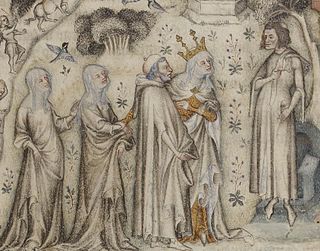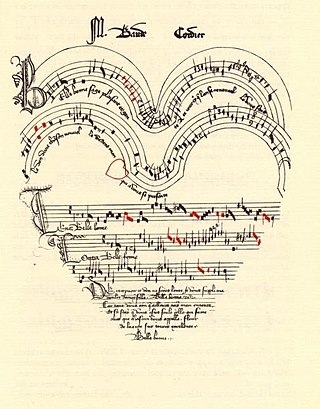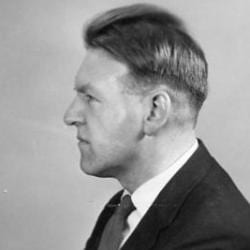Related Research Articles

Guillaume de Machaut was a French composer and poet who was the central figure of the ars nova style in late medieval music. His dominance of the genre is such that modern musicologists use his death to separate the ars nova from the subsequent ars subtilior movement. Regarded as the most significant French composer and poet of the 14th century, he is often seen as the century's leading European composer.

Ars subtilior is a musical style characterized by rhythmic and notational complexity, centered on Paris, Avignon in southern France, and also in northern Spain at the end of the fourteenth century. The style also is found in the French Cypriot repertory. Often the term is used in contrast with ars nova, which applies to the musical style of the preceding period from about 1310 to about 1370; though some scholars prefer to consider ars subtilior a subcategory of the earlier style. Primary sources for ars subtilior are the Chantilly Codex, the Modena Codex, and the Turin Manuscript.
Franco of Cologne was a German music theorist and possibly a composer. He was one of the most influential theorists of the Late Middle Ages, and was the first to propose an idea which was to transform musical notation permanently: that the duration of any note should be determined by its appearance on the page, and not from context alone. The result was Franconian notation, described most famously in his Ars cantus mensurabilis.

Baude Cordier was a French composer in the ars subtilior style of late medieval music. Virtually nothing is known of Cordier's life, aside from an inscription on one of his works which indicates he was born in Rheims and had a Master of Arts. Some scholars identify him with Baude Fresnel, a harpist and organist in the court of Philip the Bold, though other scholars have rejected this.

The Chantilly Codex is a manuscript of medieval music containing pieces from the style known as the Ars subtilior. It is held in the museum at the Château de Chantilly in Chantilly, Oise.
Historical editions form part of a category of printed music, which generally consists of classical music and opera from a past repertory, where the term can apply to several different types of published music. However, it is principally applied to one of three types of music of this sort:

Grimace was a French composer-poet in the ars nova style of late medieval music. Virtually nothing is known about Grimace's life other than speculative information based on the circumstances and content of his five surviving compositions of formes fixes; three ballades, a virelai and rondeau. His best known and most often performed work in modern-times is the virelai and proto-battaglia: A l’arme A l’arme.
George de La Hèle was a Franco-Flemish composer of the Renaissance, mainly active in the Habsburg chapels of Spain and the Low Countries. Among his surviving music is a book of eight masses, some for as many as eight voices. While he was a prolific composer during his time in Spain, much of his music was destroyed in 1734 in the burning of the chapel library in Madrid.
Richard Loqueville was a French composer active during the transition between Medieval and Renaissance music. A musician at Cambrai Cathedral, Loqueville was a harpist and teacher, whose students included Edward III, Duke of Bar and the influential composer Guillaume Du Fay.
Margaret Bent CBE, is an English musicologist who specializes in music of the late medieval and Renaissance eras. In particular, she has written extensively on the Old Hall Manuscript, English masses as well as the works of Johannes Ciconia and John Dunstaple.
The Lambeth Choirbook – also known as the Arundel Choirbook – is an illuminated choirbook dating to the sixteenth century. It contains music for 7 Masses, 4 Magnificats, and 8 motets. Much of the music is by Tudor-period composers. The major contributors are Robert Fayrfax and Nicholas Ludford; between them they contributed at least ten of its nineteen pieces. Only three of Fayrfax's works have his name attached to them, but five other pieces are known as his; these, along with two by Ludford, are known from concordances in the Caius Choirbook and other manuscripts. Seven anonymous pieces exist in the book:
Leo Schrade was a German-born American musicologist. Among his notable publications are critical editions of works by Guillaume de Machaut and Francesco Landini, the former of which he established the standard numbering scheme for. He also wrote Monteverdi: Creator of Modern Music on Claudio Monteverdi; a controversial but influential work on Monteverdi's place in the history of Western classical music.

Philip Brett was a British-born American musicologist, musician and conductor. He was particularly known for his scholarly studies on Benjamin Britten and William Byrd and for his contributions to the development of lesbian and gay musicology. At the time of his death, he was Distinguished Professor of Musicology at the University of California, Los Angeles.

Frank Anthony D'Accone was an American musicologist. He was the author of documentary studies of the musicians and institutions that produced the music of the Florentine and Siennese Renaissance. His many modern editions of the music of this culture made available to present-day performers and scholars for the first time in several centuries a wide-ranging picture of the musical life in Tuscany during the Renaissance. Musicologist Lewis Lockwood stated that his body of work "substantially extends current knowledge of the music history of the Italian Renaissance."
Jehan Vaillant was a French composer and music theorist. He is named immediately after Guillaume de Machaut by the Règles de la seconde rhétorique, which describes him as a "master … who had a school of music in Paris". Besides five pieces of music surviving to his name, he was also the author of a treatise on tuning. With Grimace and F. Andrieu and P. des Molins, Vaillant was part of the post-Machaut generation whose music shows few distinctly ars subtilior features, leading scholars to recognize Vaillant's work as closer to the ars nova style of Machaut.
The Modena Codex is an early fifteenth-century Italian manuscript of medieval music. The manuscript is one of the most important sources of the ars subtilior style of music. It is held in the Biblioteca Estense library in Modena.
P. des Molins, probably Pierre des Molins, was a French composer-poet in the ars nova style of late medieval music. His two surviving compositions – the ballade De ce que fol pensé and rondeau Amis, tout dous vis – were tremendously popular as they are among the most transmitted pieces of fourteenth-century music. The ballade is found in 12 medieval manuscript sources and featured in a c. 1420 tapestry; the rondeau is found in 8 sources and referenced by the Italian poet Simone de' Prodenzani. Along with Grimace, Jehan Vaillant and F. Andrieu, Molins was one of the post-Guillaume de Machaut generation whose music shows few distinctly ars subtilior features, leading scholars to recognize Molins's work as closer to the ars nova style of Machaut.
Magister Franciscus was a French composer-poet in the ars nova style of late medieval music. He is known for two surviving works, the three-part ballades: De Narcissus and Phiton, Phiton, beste tres venimeuse; the former was widely distributed in his lifetime. Modern scholarship disagrees on whether Franciscus was the same person as the composer F. Andrieu.

Gilbert Reaney was an English musicologist who specialized in medieval and Renaissance music, theory and literature. Described as "one of the most prolific and influential musicologists of the past century", Reaney made significant contributions to his fields of expertise, particularly on the life and works of Guillaume de Machaut, as well as medieval music theory.

The American Institute of Musicology (AIM) is a musicological organization that researches, promotes and produces publications on early music. Founded in 1944 by Armen Carapetyan, the AIM's chief objective is the publication of modern editions of medieval, Renaissance and early Baroque compositions and works of music theory. The breadth and quality of publications produced by the AIM constitutes a central contribution to the study, practice and performance of early music.
References
- CMM Home Project description and volume contents, from the American Institute of Musicology web site (archived).
- Sydney Robinson Charles, A Handbook of Music and Music Literature in Sets and Series. Schirmer Books, New York, 1972. No ISBN.